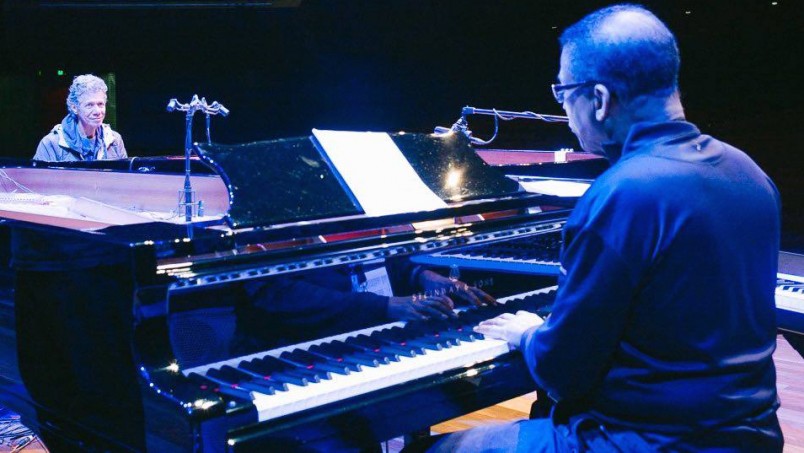 The twin pillars of 1970s jazz-fusion keyboards were Chick Corea and Herbie Hancock.
The twin pillars of 1970s jazz-fusion keyboards were Chick Corea and Herbie Hancock.
They had both been through the fire of Miles Davis’s greatest bands – Hancock most notably in the envelope-pushing Quintet of the 1960s and Corea in Miles’ envelope-puncturing electric groups of the early 70s. Unlike their contemporary, jazz pianist Keith Jarrett, both had taken to electronic keyboards naturally and immediately.
Yet there was always a side to both of them that loved the big-bellied roar and the percussive stab of the acoustic piano. In 1978 they toured as a duo, facing each other across two huge concert grands like a pair of whale-riding Western duelists. The resulting album An Evening with Herbie Hancock and Chick Corea was a best-selling jazz release.
The pair were recently out here on a tour that centred around their performance as the openers of the 2015 Melbourne Jazz Festival, but luckily also took in other capitals. Luckily one of them was Sydney.
Their Sydney show transformed the Opera House Concert Hall into a chamber of alchemy and maze-like wonders. Hancock stated that they would start with ‘nothing’ and make… ‘something’. A few short searching chords and lines and they were into it, flying like twin wizards, playing their pianos as a game, sometimes glass bead, sometimes canvas ring sparring, but always with a cosmic grin and wink.
The music grew to a depth of density very early and retained that mesh of notes and rhythms throughout the concert. Both Hancock and Corea have highly individualised approaches to harmony, and – especially in the case of Corea – rhythmic syncopation. And yet it was a wonder – among the many wonders of the night – that they rarely crowded or pushed the other into a corner. Yes, it was dense and tightly woven, but never too tight, never cloying or knottily constricted.
Their take on Hancock’s lovely 1965 piece ‘Dolphin Dance’ was so impressionistic in parts as to be unrecognisable, as were most pieces they played – but play was the thing here: the two are among a handful of the world’s greatest improvisers, so as soon as they could play with the music, they did!
During some of Corea’s romantic tunes the two stretched the harmony to new areas of dissonance that recalled the 20th Century classical shaman Bela Bartók. Yet, on Hancock’s funky groovy ‘Cantaloupe Island’ they pulled back to the blues, the fruits and the roots.
Sitting next to the two big wooden concert grands were two synth keyboards. Apart from a little ‘colour’ here and there these were reserved for a light-hearted duet of electronic beats and bleeps which Hancock seemed to relish, but which broke the spell.
The closer of the show had the two disassembling Corea’s evergreen, ‘Spain’ with the audience involved in singing a huge E major chord (muso concerts always have great crowd singing) when conducted by Corea. We also got to scat with Herbie – answering his increasingly abstracted lines.
These things gave a little sweet relief from the relentless genius of the piano improvisations. Chick Corea and Herbie Hancock gave us a ride that was uncompromising in its artistry – a few I spoke with afterwards found it too dense, too unrelenting.
I must say I am still processing the experience, and that tells me it is a good thing. Jazz needs to jolt; art needs to jolt.
At an age when many jazz musicians’ faculties have become blunt or stunted – or, worse, touchingly predictable – Chick Corea and Herbie Hancock remain seekers and hungry explorers. One of them alone is a thrill, but taken together – with each pushing, challenging and turning-on the other – they are a once-in-a-lifetime experience for anyone who digs the art of the improviser.

